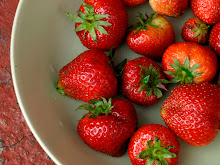Last Saturday I finally made it to Maltby Street in Bermondsey, southeast London. It's only about a 15-minute walk from the famous and overcrowded Borough Market, but it's a completely different experience. Maltby Street is a collection of artisanal food producers who have their warehouses under the railway that runs from London Bridge station. (A few of them, called the Bermondsey Seven, were evicted from Borough Market recently. Read more here.) They open to the public on Saturdays from 9am - 2pm. It's obviously popular for those in the know or those wiling to trek out to Bermondsey, but the streets are largely empty, which makes it a relaxing shopping experience. I went with a budget of £40 and ended up spending most of it. Maltby Street is not cheap, but if you're looking for something special, this is the place to come.
First I bought half a loaf of French Poilâne sourdough, butter, and chunk of a slightly matured, creamy farmhouse Irish goat cheese from Neal's Yard Dairy on Stanworth St for £14. When I got home, I made a grilled cheese with the bread, cheese, slices of finocchiona salami from Tuscany and sun-dried tomatoes. A heavenly lunch.
 |
| Fern Verrow, London (photo: Marina Vidor) |
At Fern Verrow, 55 Stanworth St, they stock biodynamically grown vegetables. I bought some fresh garlic and a huge lettuce. They also had a variety of berries (including gooseberries and josterberries), and beautiful broad beans, but I didn't indulge. In general I am still under impressed by farmers market style produce in London. The quality was fairly high, but the prices were ridiculous. Only the garlic and lettuce put me out £7.50. I don't understand this idea that fresh, high quality produce is a delicacy. Anyone who has grown vegetables and fruit knows that they always end up with way more than they can use and even if you pay people well, a lettuce and fresh garlic should not cost that much. Fern Verrow share the warehouse stall with the Borough Cheese Co. (who were selling amazing Virginia peanuts) and Coleman Coffee Roasters.
 |
| St John, London (photo: Marina Vidor) |
St John, 72 Druid St, which supplies bread to the St John's restaurants in Spitalfields and Smithfield had some nice bread, so I bought a dense white stick for £2.
 |
| Booth's, London (photo: Marina Vidor) |
Booth's on Druid St was my favorite. The range of fruits, vegetables, and mushrooms was something I'm more used to. It's not all local, but the quality was quite high. I was a bit disappointed to see some out-of-season fruit (rock hard plums), but that is to be expected in London. I bought a couple of enormous peppers, purple carrots, chives, yellow and green zucchini and an endive for about £8.50. Tonight I think I'll make pasta with the zucchini and the fresh garlic from Fern Verrow.
 |
| Booth's, London (photo: Marina Vidor) |
 |
| Booth's, London (photo: Marina Vidor) |
 |
| Booth's, London (photo: Marina Vidor) |
I ended up at Monmouth Coffee Company back on Maltby St, some of the best coffee in London. This is where they do their roasting. I got a single macchiato and a wonderful little madeleine for £3.50.
 |
| Monmouth Coffee, London (photo: Marina Vidor) |
 |
| Single macchiato, madeleine from Monmouth (photo: Marina Vidor) |
Outside, I indulged in some fennel and orange sorbet from La Grotta Ices for £2 in a cone. That was all she had left besides strawberry, but this lady has a wicked list of sorbet flavors. I wish I could go to try a new one (or two) each week.
 |
| La Grotta's offerings (photo: Marina Vidor) |
 |
| Fennel and orange sorbet, La Grotta Ices, London (photo: Marina Vidor) |
My final stop was The London Honey Company, 54-58 Tanner Place, which opens its studio on the last Saturday of every month. Unfortunately they don't take credit cards and I was out of cash, but I got to see their cute studio. The smell of honey is overwhelming. I'll be back in a month, I hope, to buy some local honey. They apparently have some from Hackney Marshes that I'd like to get my hands on, but they have hives all over the capital in the most unlikely places.
 |
| London Honey Company (photo: Marina Vidor) |
As I walked back to Liverpool Street and braved the horrendous crowds of the area around Borough Market, I felt relieved that I had spent some time in a much quieter, easy-going place. Maltby St seems to be a place for local foodies and people looking for that special treat. Lots of Italians, French and American customers, as is customary to see in specialty food markets in the capital, and trendy 30-something British people. (I wonder if being Italian-American doubly predisposes me to food obsession.) At any rate, this is not your normal food market. If you're looking for a great deal, this is not the place, but if you want a peaceful, quality foodie indulgence experience, head on over to Maltby St and enjoy!
 |
| My loot from Maltby Street (photo: Marina Vidor) |
Personally, my next trip will be to get some honey, a coffee and some of that amazing sorbet.


















